Everything about laminate flooring is provided in the section below. We’ll discuss the materials used to make laminate, its cost, its longevity, the locations in which it can be installed, how to install it, and even some advantages and disadvantages.
Laminate flooring is a composite flooring material. It’s composed of multiple layers, it’s been around for about 50 years, and it’s designed to add style and value to your home while withstanding wear and tear. Most frequently (though not always), it is made to look like wood.
However, that is merely the tip of the iceberg. There are many different types of laminate flooring available right now, each with specific advantages and disadvantages. And while it’s often written off due to its comparatively low price point and formerly-artificial appearance (xoxo the 1980s), laminate flooring has really come into its own as a strong, attractive, economical, and low-maintenance type of flooring.
For more information, keep reading.
What is Laminate Flooring?
A type of synthetic, composite flooring is laminate flooring. A plywood or fiberboard core layer makes up the base of the flooring. For added protection and insulation, a backing layer or underlayment may occasionally be added to the bottom of this core layer. The image layer—a high-resolution printout of actual wood, stone, or another material—is adhered on top of the core layer.
In order to shield the lower layers from harm, a thin and transparent wear layer made of plastic is added.
The look of wood or stone floors can be duplicated with laminate flooring without having to pay the higher price for those floors. Despite having a reputation for looking artificial and cheap in the past, it is now regarded as being high-quality, long-lasting, and low-maintenance due to the availability of more excellent photorealistic image layers.
Pros
Durable: Laminate floors are incredibly durable considering how little maintenance they require. Laminate is waterproof, UV resistant, and can withstand heavy traffic with little damage. Additionally, it does not scuff or deteriorate as quickly as hardwood floors.
Affordable and easy installation: Comparatively inexpensive to other types of flooring, laminate floors are also simple to install as a do-it-yourself project.
Decently eco-friendly: Laminate flooring made of recycled materials, especially the core layer, is becoming more and more prevalent. Reputable companies will also provide some kind of environmental certification, like GreenGuard.
Cons
Susceptible to liquid damage: Laminate floors are sensitive to moisture. If left untreated, oversaturation with any liquid—not just water—can cause the planks to buck, stain, and crumble. Though waterproofed laminate floors are becoming the norm, it is still important to exercise caution, especially if water gets underneath the floor. Water-damaged planks or tiles need to be completely replaced.
Cannot be refinished: A laminate floor can never be refinished because of its composite design and wear layer. Laminate flooring needs to be changed once it has been harmed or worn out.
Unfortunately, laminate flooring, regardless of its quality, cannot pass for its real counterpart when closely examined. A laminate floor will be noisier, for example, than a hardwood floor, and everything from pattern repetition to how the floor feels and sounds underfoot are signs that a laminate floor is, well, laminate.
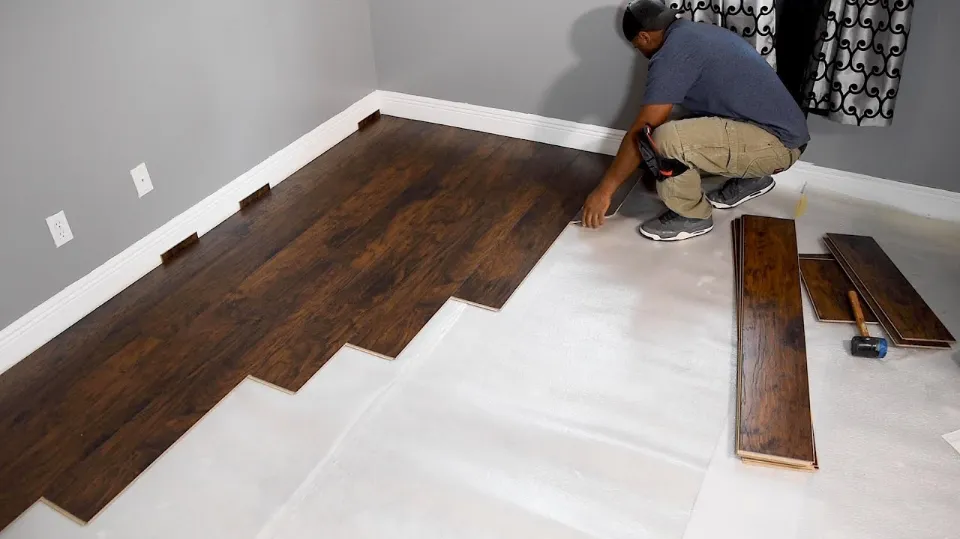
How Much Does Laminate Flooring Cost?
Back in the day, laminate used to be considered “cheap” or low-end—but that’s a relic of another time. These days, technological advances have made this material both stylish and affordable.
The wear layer is no longer the plasticky-looking high-gloss you might recall from laminate’s early days, and its price point varies greatly.
The price of laminate flooring will depend on the quality, but you can estimate spending between $0.70 (for woods like maple or red and white oak) and $2.00 (for something like hickory) per square foot. Non-wood laminate floors will be within the same range. Expect to pay more for any additional features or qualities, such as waterproofing or specialized designs.
Is Laminate Flooring Easy to Install?
It’s very simple to install laminate flooring. The best way is to float it over an underlay. You won’t require any specialized tools, glue, or nails. It has become very well-liked among DIY enthusiasts in part because of this.
Prepare Your Floor for Installation
There are a few steps to take in order to get ready to install your new laminate floor. Your new laminate needs time to adjust to its surroundings. The entire floor should be placed in the center of the room (in the sealed packs) and left there until installation is ready. A minimum of 48 hours must pass before removing it. The room should be at a comfortable temperature and free of any recent cement or plaster work. You will also need to prepare your existing subfloor. Your current flooring (old laminate, carpet, wood, etc.) must be removed.). A flat, level, dry, and clean floor is required.
You can begin installing your laminate floor as soon as all of your preparations are finished. Which underlay you need should already have been determined. For underfloor heating, either standard or underlay. Lay it out after cutting it to size. A full plank should be laid down where you want to begin installing the laminate. Next, simply click and lock each flooring plank into place. The planks may be difficult to click together in some small spaces up against walls. A floor fitting kit might be useful to make the process simpler. Remember to leave an expansion space around the room’s perimeter when installing your laminate floor. This applies to areas such as doorways and pipework. The expansion gap must be at least 10mm wide. That the floor can naturally expand and contract is made possible. Once your floor is installed, the gaps can be filled in with skirting, beading, and pipe covers.
Maintain Your Laminate Floor
Your new laminate floor is incredibly simple to maintain and care for. Keep it tidy by sweeping frequently. With a wood floor cleaner spray and a mop, you can get rid of more difficult stains. Remember to wipe away water straight away and protect you floor from damage by using felt protector pads on the bottom of furniture.
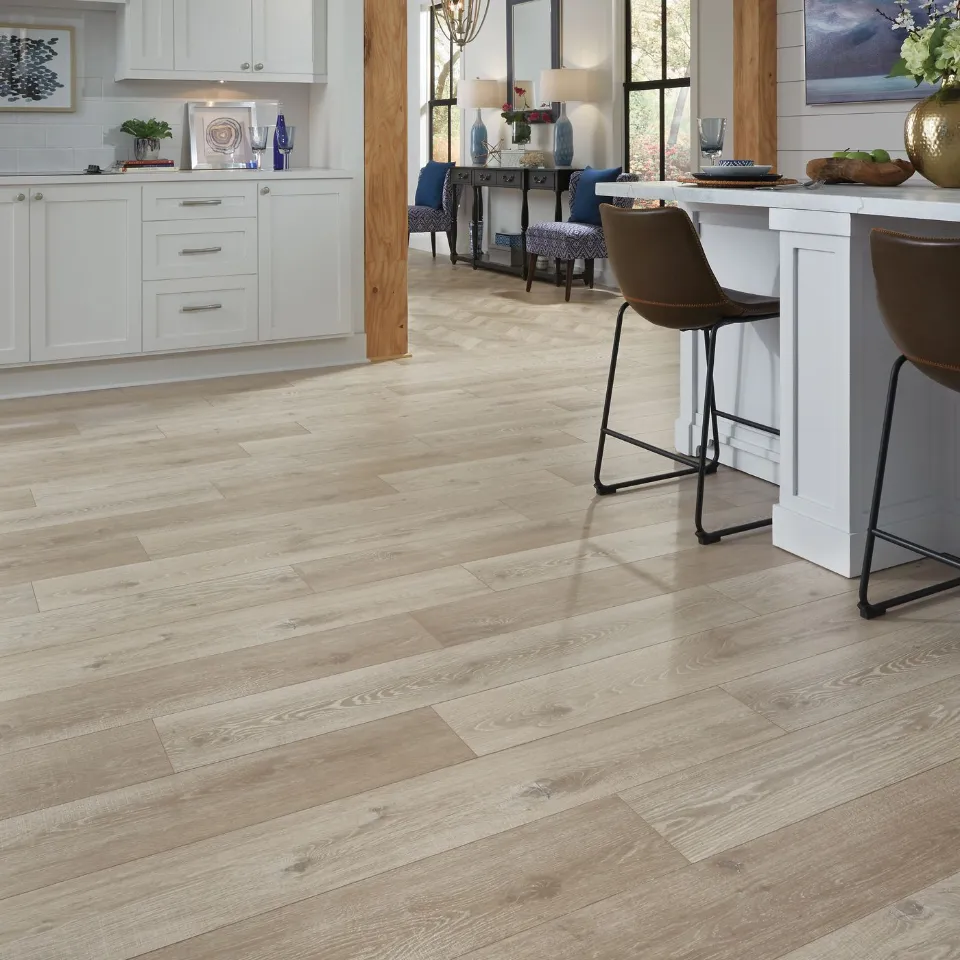
Which Rooms in My Home Can I Use Laminate Flooring?
Laminate flooring has a lot of different uses. In almost every room of your house, you can use the floor. It is made to be strong enough to withstand normal wear and tear, making it a perfect option for hallways, living spaces, and bedrooms. It is possible to find flooring with lovely designs. This will enable you to match it to any theme or style and give your room a brand-new appearance. Some laminate flooring varieties are water resistant, making them better options for spaces like dining areas and hallways where water or drinks may be present. Quick-step even have a range of laminate flooring (Hydroseal) that is waterproof and provides 100% resistance to moisture. If you decide to install laminate flooring in wet areas like bathrooms, kitchens, or utility rooms, this is advised.
How Durable is Laminate Flooring?
In a word: very. If your floors need to endure a lot of wear and tear, laminate is one of the best types of flooring you can buy. Because what is laminate flooring if not super-tough?
Laminate Flooring Easily Resists Stains and Scuffs
Maintaining new floors isn’t easy (even if you don’t have kids or pets). However, one of the most durable floors available is laminate. Its durable wear layer is difficult to penetrate, so it’s hard to stain or gouge. Again, you won’t find a more scratch-resistant flooring option anywhere besides PVC flooring or particular kinds of floor tiles.
Like we previously stated, laminate is fantastic for high-traffic areas, especially if your home is not a no-shoes-off house. Whether you’re coming home from a long day in your work boots or whether you’re dragging in your Amazon Pantry box from the porch, scuffs and scratches are a part of life. Laminate stands up to wear and tear so you can keep your floors looking newer, longer.
Is Laminate Flooring Kid-friendly? is Laminate Flooring Pet-friendly? Absolutely.
Does your dog suddenly turn around when it hears the crinkle of a food wrapper? Are your kids prone to spontaneous juice spills and glitter explosions? Here for you is laminate.
We love our kids and pets… but not every type of flooring does. You should consider how well each floor will function for every member of your household when choosing which ones to install in your home.
You’ll appreciate laminate flooring’s high level of durability and easy maintenance for new puppies or slightly older children. The best wood flooring for dogs has nothing on laminate’s scratch-resistance.
But remember: more durable floors are usually harder floors, and laminate is no exception. Do you have a young child learning to walk or an elderly dog who might benefit from a softer surface?
Is Laminate Flooring Waterproof?
We discussed this a bit earlier, but yes—laminate can be a waterprofo floor. However, it entirely depends on what kind you buy!
Regular ol’ laminate is water-resistant, in the same way that engineered wood is water-resistant. You won’t have any issues as long as liquids are quickly cleaned up. Due to laminate’s wear layer’s strength and ability to withstand moisture, it is ideal for the occasional small spill or pair of wet rain boots.
However, swelling and warping are possible if water penetrates between the planks and is absorbed into the core layer.
But again, this is not an issue if you buy a specialty waterproof laminate product like RevWood!
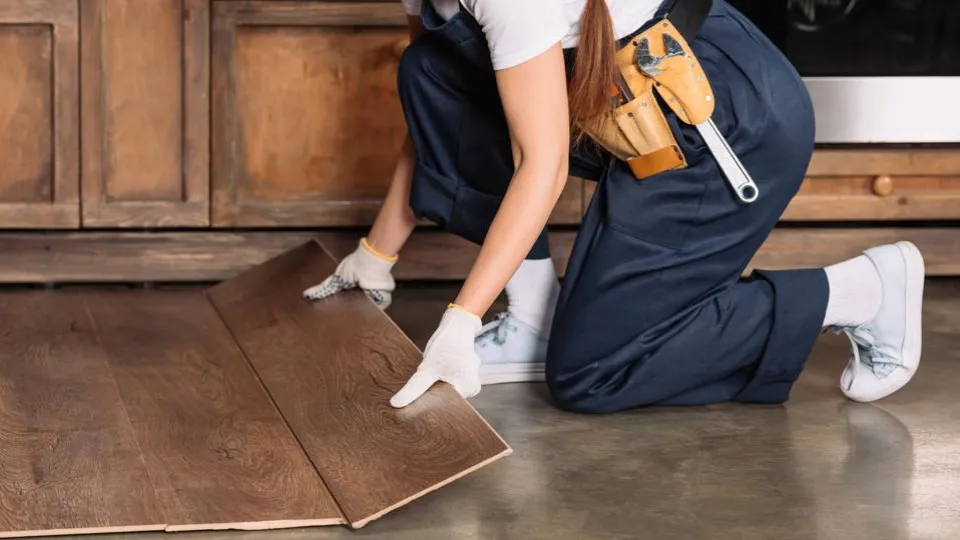
Is Laminate Flooring Comfortable?
Indeed, laminate has a wonderful cushiony feel underfoot thanks to the fiberboard or plywood base layer. In actuality, some extremely expensive EVP flooring products (WPC flooring in particular) are the closest surfaces to quality laminate when it comes to faux wood flooring in terms of comfort.
However, just like with all floors, the comfort of laminate depends on a variety of elements, such as the product, the price range, the underlayment, and the method of installation.
Underlayment Can Increase Laminate Flooring’s Comfort…
Much of the comfort level of any flooring has to do with how it interacts with the subflooring beneath it. Laminate is no exception. You might wonder what subflooring is. Your floor joists are covered by this flat surface, which is typically made of concrete or plywood.
To achieve an incredibly comfortable floor, an underlayment can be added between the subfloor and the finished surface. A built-in plastic underlayment is included with some types of laminate flooring to guard against moisture. Others have felt or foam underlayments that act as padding, absorb sound, and lessen the physical impact of your footfalls. Your choice of product is everything!
If the type of laminate you select does not already have an integrated underlayment, you might want to think about adding one. For more advice on using underlayment to improve the comfort of various types of flooring, speak with a local expert in the field.
…as Can Certain Installation Methods
There are numerous ways to install laminate, which we’ll go over shortly. Some of these methods can be more comfortable than others. Floating floors, for instance, can offer more bounce—but are sometimes said to feel a bit “hollow”. What is a floating floor? It’s just a surface that rests above your subfloor, rather than being attached to it.
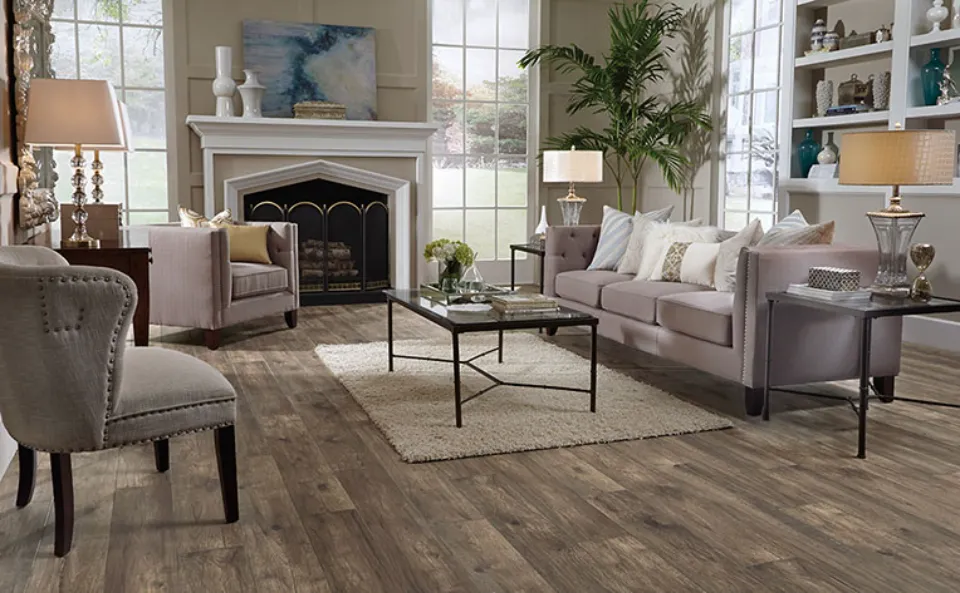
Is Laminate a Low-VOC Floor?
Low-VOC flooring is more common than ever these days—and for good reason. Volatile organic compounds, or VOCs, can be released from a variety of industrially produced materials, including flooring.
In fact, you may remember that not too long ago, Lumber Liquidators (since rebranded as “LL Flooring“) was caught selling toxic laminate products from China that harmed their clients’ health.
Luckily, most laminate is not harmful. And thankfully, non-toxic laminate flooring has become the standard in the wake of the Lumber Liquidators scandal. Make sure your laminate is low-VOC certified before you purchase, is our advice.
Is Laminate Eco-friendly?
The answer to this question depends on your definition of eco-friendly flooring, but yes—overall, yes! One of the greenest flooring options available is laminate.
This is due to the fact that it uses primarily organic materials (plywood or fiberboard) for its core layer and very little synthetic material for its wear layer. This means it’s largely recyclable.
Compared to vinyl, this makes laminate the much more eco-friendly choice. Vinyl plank flooring’s complete plastic composition is one of its biggest drawbacks. This indicates that, aside from a few lesser-known companies like Proximity Mills, it isn’t really typically recyclable.
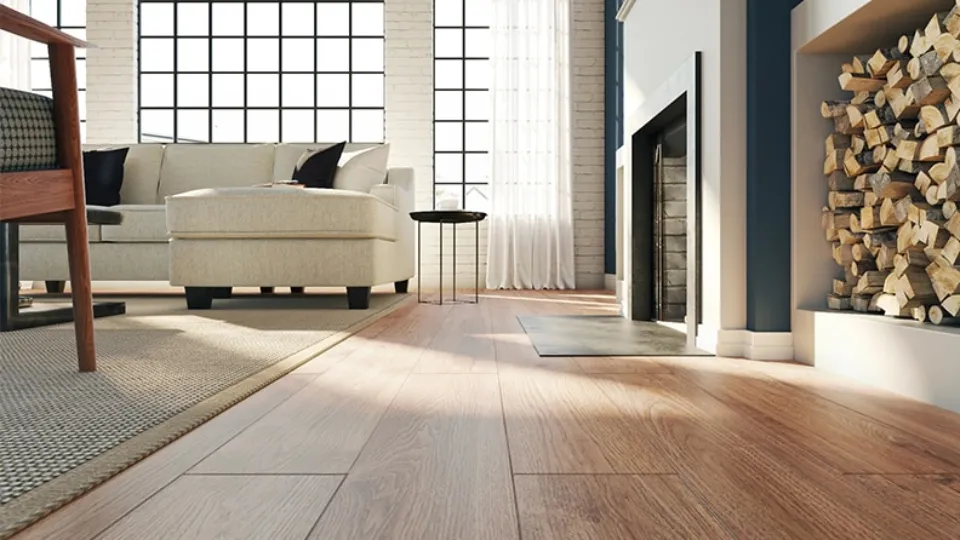
Quality Varies in Laminate Flooring Brands
As mentioned earlier, the mass production of laminate flooring products via many manufacturers worldwide may cause variation in terms of product quality and standard. Homeowners may have to look deeper in terms of certain criteria before choosing the right laminate flooring brand for their homes. Here are some significant facts about laminate flooring that homeowners should consider.
- Slip Resistance
Verify that the laminate flooring has undergone rigorous tests to determine its level of slip resistance.
- Impact Resistance
Good quality laminate flooring products have a relatively higher level of impact resistance and heavy load tolerance. Thus, this will improve home security.
- Better Indoor Quality
Though most laminate flooring has E1 or E0 emission rating for formaldehyde which is considered good for indoor air quality. Superior quality laminate flooring products have gone even stringent indoor air quality control such as Floor Score.
- Eco Friendly
Here, two things should be noted. Make sure the laminate flooring has been tested for high eco sustainable standard such as The Singapore Green Label and renowned Nordic Eco label (or the green swan label).
- Easy Maintenance
Products made of high-quality laminate flooring are simple to keep clean and maintain.
- Water Resistance
Comparatively more water resistance is tested for in higher quality laminate flooring products than it is for the majority of lower quality laminate flooring products.
- Scratch Resistance
The scratch resistance of high quality laminate flooring brands improves the flooring’s value.
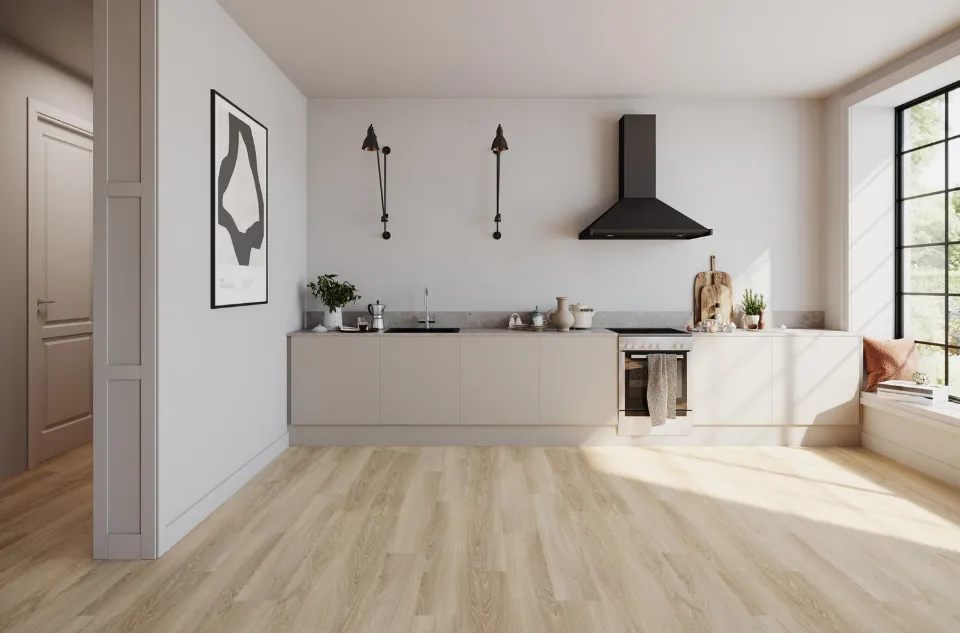
FAQs
What is Difference Between Laminate and Vinyl Flooring?
The components made up of which they are constructed are the primary distinction between laminate and vinyl flooring. Vinyl is 100% synthetic, while laminate uses a fiberboard core constructed of wood byproducts. As a result, vinyl flooring is completely waterproof while laminate flooring is not.
Is Laminate Flooring Wood Or Plastic?
Laminate flooring is made of a thin, pressed wood board with a repeating printed image of wood fused onto a fiberboard core. One thing to note about laminate flooring is that it is not made from plastic but from a collection of wood fibers with a top layer of resin acting as a “wear layer”.
Are Laminate Floors Better Than Wood?
Laminates last longer, install easier, are more eco-friendly are absolutely gorgeous and, with their embossed grain or hand scraped finishes, impossible to tell apart from hardwoods. And they are typically still much cheaper than hardwoods.
Can You Mop Laminate Flooring?
To keep laminate floors fresh, mop them every two months. Laminate floors can be cleaned with damp mops, also known as microfiber mops. If you intend to use a regular mop, simply wring it out until it is nearly dry.
How Long Do Laminate Floors Last?
Laminate flooring lasts between 15 to 25 years on average. The exact lifespan will vary depending on the product quality of your floor, how well you maintain and care for it and the overall wear-and-tear it receives. Laminate floors can occasionally last more than 25 years. It frequently won’t last ten.
Summary: What is Laminate Flooring?
Laminate flooring is a composite flooring material. It’s composed of multiple layers, it’s been around for about 50 years, and it’s designed to add style and value to your home while withstanding wear and tear. Most frequently (though not always), it is made to look like wood.
If you’re looking for an affordable, durable floor with plenty of design options and an easy installation process, laminate flooring may be the right choice for you. Weigh carefully the artificiality of laminate against the much higher cost (both financially and in terms of maintenance and longevity) of other materials.
If you have any questions, please leave a comment. My Prime Home tries to give you the best home improvement information. Don’t forget to share the post. Thank you for reading.
See also:



